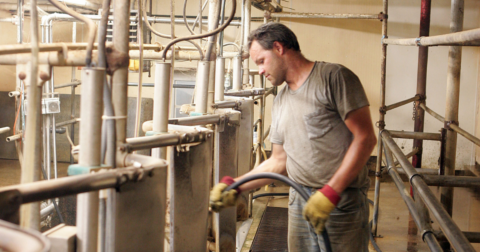Solutions
Urban Foragers Are Mapping Edible Plants Around the World
Climate•5 min read
Feature
A new report details the toll of nitrate pollution linked to manure from growing industrial farms.


Words by Nina B. Elkadi
Since the day he moved into his new home, Tyler Frye’s well water has been too contaminated to drink without costly filtration. In March 2022, he paid $370,000 for a brand-new house in Casco, Wisconsin — only to later discover his private well’s water was unsafe to drink. Frye’s story is far from unique, with an estimated 10 percent of Wisconsin residents facing similar contamination in their wells.
“I bought the house assuming that it was a new house. I didn’t think there would be any problems,” he says. “I took advantage of nitrate testing the county was advertising on the news, and found out my well was testing at 26.6 milligrams per liter for nitrate.”
The Environmental Protection Agency sets the maximum safe level for nitrate in U.S. drinking water at 10 milligrams per liter. Consuming too much nitrate can increase the risk of cancer and other diseases, and some experts warn that those risks may even occur below the regulatory limit. Infants are especially vulnerable because nitrate exposure can cause an acquired form of blue baby syndrome, which deprives the blood of oxygen and can be fatal.
According to a new report from the Alliance for the Great Lakes, more than 90 percent of the nitrate contamination in private and public wells across Wisconsin is from excessive manure and fertilizer application by the agricultural industry. Nitrate forms when soil microbes break down nitrogen fertilizers such as manure. Nitrogen is essential for plant growth, but overapplying fertilizer leaves excess nitrate that dissolves in water and leaches into groundwater. Pollution can also occur when manure storage lagoons at concentrated animal feeding operations leak into the soil.
The report paints a grave picture of nitrate pollution in Wisconsin, a state with approximately 3.25 million farmed cattle and calves and 58.6 million chickens. Frye is just one of many residents facing a lack of access to drinking water. As the number of farmed animals in Wisconsin increases, so can nitrate pollution—deepening a water crisis that already flows from the Midwest to the Gulf of Mexico.
Addressing the problem of contaminated wells comes with significant personal and public utility costs. Frye spoke about how he’s locked into his situation at a community meeting in his region of Kewaunee County. He discovered the nitrate-contaminated water after purchasing his home. He invested in a $900 reverse osmosis water filter system, and that price doesn’t include the added expense of replacement filters at around $150 per year.
In July of this year, Frye and his wife welcomed a daughter into their family.
“My wife drank bottled water during pregnancy and currently while nursing,” he wrote in an email to Sentient. The reverse osmosis filter “knocks the nitrates down but doesn’t completely remove them.”
Frye’s story is becoming the norm, not the anomaly, in Wisconsin. There are five times as many cows as there are humans in his home county. Dairy herd sizes have grown in recent years, partly because new technologies such as methane digesters incentivize farms to produce more manure to, in theory, capture more methane and earn additional carbon credits. A case study of dairy farms in Kewaunee County, published by Friends of the Earth and Socially Responsible Agriculture Project, showed that “herd sizes at CAFOs with a digester grew by 58 percent.”
The manure from these CAFOs can also be applied to cropland as fertilizer. According to the Alliance for the Great Lakes report, fertilizers are overapplied, which leads to nitrate leaching into groundwater. In four of nine Wisconsin counties studied, nitrogen-based fertilizer, including manure, was applied at a rate 50 percent higher than that recommended by University of Wisconsin Extension agronomists.
Multiple public water utilities throughout Wisconsin have invested millions into nitrate-removal facilities. In Portage County, the cost of filtering out nitrates at the Plover Water System has amounted to approximately $6.8 million, or roughly $504 per customer. In Rock County, the Janesville Water Utility was forced to abandon a contaminated well and then built three nitrate blending facilities for about $33 million. In Trempealeau County, the Wisconsin Groundwater Coordinating Council, a statewide interagency group, estimates it would cost over $10.05 million to dig deeper wells to replace those that have nitrate levels exceeding the EPA safe drinking water standard of 10 mg/L.
Angela Blatt, the senior agriculture policy manager at the Alliance for the Great Lakes, tells Sentient that the cost to drill a new well can range anywhere from $3,800 to $29,000.
“One of our participants was the owner of a daycare center, and the estimate to replace the well was going to be $75,000,” Blatt tells Sentient. Some people who cannot afford to dig a well install a reverse osmosis system, which comes with its own costs and upkeep. “Those costs add up.”
The nitrate contamination problem extends far beyond Wisconsin’s state lines. Iowa faces extreme nitrate contamination, spurring what some experts are calling a water quality “crisis.” Just this summer, Des Moines, Iowa, implemented a lawn watering ban for the first time. The decision was made in response to record-high nitrate levels in the city’s primary sources of drinking water, the Raccoon and Des Moines rivers, prompting an effort to conserve water and ensure that there was enough safe drinking water for residents. Nitrate pollution travels from the source to distances much farther than the Midwest. After entering waterways via groundwater and runoff, nitrates are carried down to the Gulf of Mexico, where they feed harmful oxygen-depleting algae, resulting in “dead zones” where life can’t be sustained.
Frye tells Sentient that something needs to change. The Casco resident has been attending local community meetings and has reached out to his local politicians, the Environmental Protection Agency and the Department of Natural Resources.
“No one’s really given me a solution on what to do,” he says. He has been encouraged to apply for well compensation grants, but his family makes more income than the cutoff. The geology of his home, too, would make drilling a new well difficult. Even after drilling a new well, some residents still have nitrate and mercury in their water.
The Alliance for the Great Lakes report advises policymakers to expand the private well compensation program. It also recommends stricter regulations for concentrated animal feeding operations, including groundwater monitoring. More centralized data is also necessary to really understand the scope of the problem. It can be difficult to see the true fiscal impact of this pollution state-wide, the report authors note, because there isn’t consistent data about how much the municipalities are spending.
“Without a coordinated science-based response to address the pollution at its source, we’re only going to see rising financial and human costs for this issue,” Blatt says.
Last year, Frye’s well water tested at 14.3 mg/L. The reverse osmosis filter gets most of it out, but still a little bit remains. This is why his wife drank bottled water during her pregnancy, and why she still does as she nurses.
This month, they will test again.